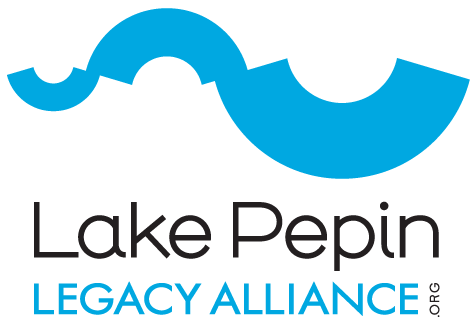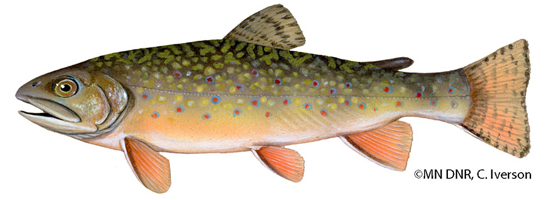This article is part of a larger series that investigates what we know about local tributaries around Lake Pepin. Follow us on Facebook and sign-up for our e-newsletter so you don’t miss the next release. If you have information or pictures for other Lake Pepin tributaries, please email us at: info@lakepepinlegacyalliance.org.
By: Emily Green
One of Lake Pepin’s Wisconsin tributaries, Isabelle Creek starts near the Village of Ellsworth, flows south through Pierce County, and enters the Mississippi at Bay City. Abundant groundwater springs, located around the midway point of its 13-mile run, feed Isabelle’s waters.
Historically the creek’s perennial flow started from those springs, with the upstream channel filling only during seasonal rains. But for decades, discharge from the Ellsworth Creamery and the municipal wastewater treatment plant into Isabelle’s channel have ensured perennial water flow throughout its entire length.
Wisconsin Department of Natural Resources (WDNR) fisheries biologist Kasey Yallaly described Isabelle as “your typical, beautiful, coulee, driftless-area stream and valley,” which also means it runs down a steep gradient from headwaters to mouth, and is highly prone to flash flooding and bank erosion. Also typical of driftless-area streams, farming activities in the late 19th and early 20th centuries resulted in severe erosion of its upland soils and streambanks, altering its hydrology and badly degrading its natural trout habitat. Like most driftless-area streams, Isabelle historically experienced near-total extirpation of its native brook trout population.
Soil conservation farming practices since the 1930s, combined with restoration efforts and fish stocking, have helped Isabelle and other driftless-area streams improve to the point of hosting trout again. The WDNR does annual assessments of fish communities in many rivers and streams. In Isabelle’s case, most of its lower reaches are now considered by the WDNR as “good” or “fair” habitat for non-native brown trout that, once introduced, have come to be Isabelle’s dominant fish. Few to no trout are found in its upper reaches.
Yallaly noted that there has been some effort by the WDNR in recent years to reintroduce brook trout in Isabelle, and WDNR fisheries staff hope to evaluate the success of that effort in the next few years. According to a 2017 WDNR Stream Classification report,
“overall conditions appear to be improving in Isabelle,”
a trend that is widely credited to improvements in upland land management since the 1990s.
WI lists Isabelle as a ‘healthy’ stream, but has only been assessed for phosphorus and biota
Beyond its overall improving fishery, Isabelle Creek appears on WDNR’s Healthy Waters list, which was created in 2018 and identifies all waters that were “assessed for at least one [water quality] metric and show no impairment.” The WDNR water quality monitoring program samples a subset of the state’s waters each year, selecting some that are specifically targeted for monitoring and others through a random selection process designed to capture a general picture of the state’s water quality. Isabelle was sampled in 2015, 2017, and 2018 and, according to WDNR Water Quality Biologist Chris Willger, it meets WI’s water quality standards for the two metrics applied to streams: phosphorus levels and biotic indicators, including both fish and macroinvertebrate communities.
WI and MN ‘healthy’ and ‘impaired’ stream categories can’t be easily compared
Accompanying Isabelle on WI’s Healthy Waters list are two more Lake Pepin tributaries: Pine Creek and Rush River. All told, the categorizing of Lake Pepin’s Wisconsin tributaries as “healthy waters” paints a somewhat curious contrast with Lake Pepin’s Minnesota side, where all of the tributaries have been found by the MN Pollution Control Agency (MPCA) to be impaired water for aquatic recreation due to elevated E. coli.
However, this ostensible contrast belies the true story:
MN and WI have some key differences in how they assess and categorize their waters, thus their “healthy” and “impaired” categories are not simply, directly comparable.
Both Minnesota and Wisconsin consider bacteria such as E. coli as a measure of whether water bodies support recreational use, but Minnesota measures bacteria levels far more often, and in far more of its rivers and streams. Willger explained that WDNR doesn’t routinely monitor its streams and rivers for bacteria such as E. coli (*It should be noted that Wisconsin adopted a more stringent bacteria standard in 2020 so, according to Willger, its bacteria monitoring could change going forward). Instead, WI’s county health departments test for bacteria only in sites where there is specific concern about full body human exposures such as public beaches and river stretches popular for tubing.
Beyond their differing approaches on bacteria, Minnesota and Wisconsin’s water quality programs differ in several other ways. For example, Wisconsin has a standard for phosphorus--a principal component of agricultural fertilizers and organic waste that causes dense algae growth and depleted oxygen in water when it occurs at elevated levels. Meanwhile Minnesota’s comparable but more comprehensive standard is for “eutrophication,” which is a metric combining phosphorus levels and other indicators of algal growth such as chlorophyll, dissolved oxygen, and pH. Minnesota has a standard for sediment levels in coldwater trout streams, Wisconsin does not.
Unlike Wisconsin, Minnesota does not create a healthy waters list. If it did, and it used Wisconsin’s criteria, Gilbert, Bullard, Hay, and Miller Creeks would all presumably rank as “healthy” given that all support healthy trout populations and meet Minnesota’s standards for aquatic life.
Different state water quality approaches lead to divergent statewide pictures
Differing water quality programs among states reflect the fact that they have some latitude in how they comply with the requirements of the federal Clean Water Act, the nearly 50-year-old law that requires states to assess the quality of their surface waters, publicly report the results, and create plans to clean up impaired waters. Each state’s differing approach can result in seemingly very different statewide water quality pictures.
Notably Minnesota and Wisconsin, despite having some distinct landscape and land use similarities, have markedly different published water quality statistics: Wisconsin says 18% of its waters statewide are impaired while Minnesota posts a 56% impairment rate. According to MPCA Impaired Waters List Coordinator Miranda Nichols, a major factor driving that contrast is the fact that Minnesota does substantially more monitoring than Wisconsin.
A comparison of bacteria monitoring helps to illuminate the different approaches. The USEPA’s “How’s My Waterway” website, shows that as of 2018, MN had assessed more than 13,000 river and stream miles for safe recreational usage, through measuring bacteria such as E. coli. They categorized 4,743 miles as “good” and 8,407 miles as “impaired,” while 1,277 miles were found to have “Insufficient information” to make a categorization. In contrast, as of 2020 WI had assessed 318 river and stream miles for aquatic recreation and found about half to be good and half to be impaired.
“On paper their assessments and their monitoring look very similar . . . But if you go looking for the data, there's just not the volume of data [for Wisconsin] that we have [in Minnesota].” Bacteria is a prime example. “It's not that there's no bacteria [in Wisconsins’ streams], you only find it if you look,” stated Nichols.
Most of MPCA’s water quality monitoring work in Minnesota is funded by the Clean Water Fund, established by the Clean Water Land and Legacy Amendment in 2008. Wisconsin does not have a comparable designated public funding stream to fund its monitoring efforts. “[Minnesota has] more money than other states to do this work. . . We are extremely lucky. That Legacy funding goes a long way,” concluded Nichols.







